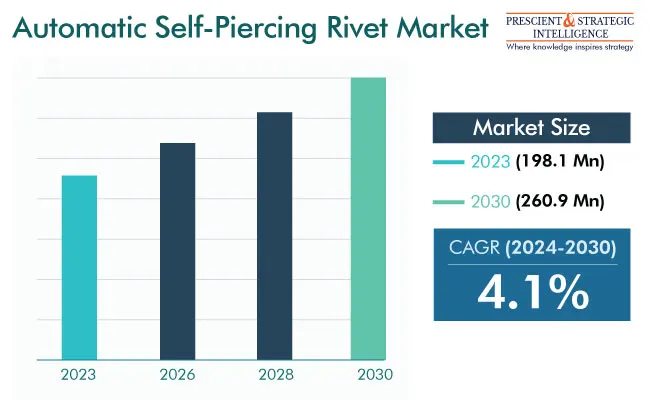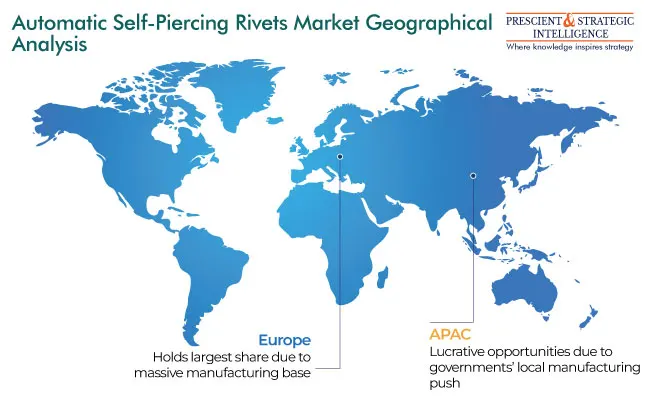Report Code: 10905 | Available Format: PDF
Automatic Self-Piercing Rivets Market Size and Share - Global Growth & Demand Forecast to 2030
- Report Code: 10905
- Available Format: PDF
- Report Description
- Table of Contents
- Request Free Sample
Automatic Self-Piercing Rivets Market Overview
The global automatic self-piercing rivets market generated revenue of USD 198.1 million in 2023 (E), and it will propel at 4.1% CAGR during 2024–2030, to touch USD 260.9 million by 2030.
This is because of the improved automation in manufacturing, the surging need for lightweight vehicles, cost-effectiveness, developments in material technology, and the rising emphasis on sustainability.

- According to a survey, over 90% of the workforce said automation solutions enhanced their efficiency.
- 85% said automation drives collaboration across the teams.
- Also, around 90% of the workforce trusted automation solutions to get more done without faults and aid them make decisions quicker.
One of the main features of automatic self-piercing rivets is that they are a revolutionary solution for lightweight construction in the aerospace and automotive sectors. With the growing importance of fuel efficiency, emission reduction, and structural integrity, this technology has become an integral component in joining materials necessary for those sectors. The rivets' capability to make robust, consistent bonds without affecting the integrity of materials makes them an important enabler for attaining the goals of weight reduction. This enhances the total performance of manufacturing procedures and contributes to the development of efficient and sustainable industrial processes.
Drivers
- Improved Automation in Manufacturing: The development of automation in manufacturing is driven by higher labor costs as well as faster production. Automatic self-piercing rivets' compatibility with installation systems and automated feeding makes them suitable in this area.
- Surging need for Lightweight Vehicles: The automotive sector is focusing on fuel efficiency and lower emissions, which is accelerating the use of lightweight materials such as aluminum and composites. Automatic self-piercing rivets offer robust and dependable fastening without pre-drilled holes, and therefore, they become the ideal selection.
- For example, decreasing the body weight of a car by over 1 kg can lead to a 20 kg decrease in the amount of carbon dioxide the car produces throughout its lifetime.
- Moreover, the global demand for automotive lightweight material will touch USD 128,010.1 million by the end of this decade.
- Cost-Effectiveness: Automatic self-piercing rivets, compared to conventional riveting process, provide quicker installation, decrease labor expenses, and possibly decrease overall assembly expenses.
- Developments in Material Technology: Advancements of new materials with greater strength, broader operating temperatures, and corrosion resistance increase the application areas for this technology, particularly in demanding sectors such as construction and aerospace.
Trend
Increasing government initiatives to promote the adoption of automatic self-piercing rivets is a major trend being witnessed in the industry. Analysts observed that the rising government strategies relating to fuel efficiency and decreasing carbon dioxide emissions, including automobile efficiency incentives, global fuel economy initiatives have substantially assisted in shifting the landscape of vehicle manufacturing.
- Global Fuel Economy Initiative has set a goal of enhancing the fuel economy for new vehicles across the globe by at least 50% through 2030
- The target year to attain 50% fuel economy in the case of light vehicle fleet is 2050.
This trend is likely to result in the growth of automatic self-piercing rivets in the automotive industry.
Challenge
- High Initial Capital Investment
- Material Compatibility & Thickness Limitations
The initial capital investment of adopting automatic self-piercing rivets is high. The expenses for obtaining and employing this technology, for instance buying specialized equipment and conducting training, can be a challenge for small- and medium-sized businesses, and those with limited financial means. Tackling this problem requires industry stakeholders to look for financing possibilities, encourage collaborative initiatives, and showcase the long-term cost savings related to this technology.
Although automatic self-piercing rivets show exceptional capability in joining lightweight materials, they become a challenge when dealing with certain material thicknesses and combinations. Automatic self-piercing rivets might face problems in piercing and forming joints in materials with extreme variations in hardness or thickness.
Conventional Vehicle Accounts Largest Share
The conventional vehicles category, based on application, accounts for the largest share of the industry. This is because the automotive sector remains a major user of this technology owing to the surging demand for lightweight materials, including high-strength steel and aluminum. Moreover, the continuing acceptance of petrol and diesel-driven vehicles is also assisting the category expansion.
- For instance, the sales of petrol vehicles in India in 2023 were around 3.9 million units, an increase of 26% from 2022.
Moreover, its exclusive capability to accurately and efficiently join such materials without pre-drilling comes in line with the automotive industry's pursuit of improved structural integrity and fuel efficiency. This solidifies the major role of automatic self-piercing rivets as an essential component in producing conventional vehicles.
Almac coating Is Largest Contributor
The Almac category, based on coating, is the largest contributor to the industry. This is because of the fact Almac coating offers excellent corrosion resistance as well as durability, which has boosted their acceptance across different industrial applications. Moreover, its capability to endure severe environmental situations without compromising structural integrity has enhanced its position as the key solution for improving the performance and longevity of self-piercing rivets.
With the rising focus of industries on reliability and quality, the demand for Almac-coated rivets will continuously rise, emphasizing its important role in driving innovation and growth in this industry.
| Report Attribute | Details |
Market Size in 2023 |
USD 198.1 Million (E) |
Revenue Forecast in 2030 |
USD 260.9 Million |
Growth Rate |
4.1% CAGR |
Historical Years |
2017-2023 |
Forecast Years |
2024-2030 |
Report Scope |
Market Trends, Drivers, and Restraints; Revenue Estimation and Forecast; Segmentation Analysis; Impact of COVID-19; Companies’ Strategic Developments; Market Share Analysis of Key Players; Company Profiling |
Explore more about this report - Request free sample
Europe Is Dominating Market
Globally, Europe accounts for the dominating share of the industry. The dominating position of the region is ascribed to the burgeoning manufacturing capability, strict quality standards, and robust effort on lightweight construction in the aerospace and automotive sectors. Moreover, in Europe, Germany is playing an important role in driving regional industry growth. The nation’s developed manufacturing abilities, flourishing automotive sector, and technological innovation make it the major contributor to the utilization and adoption of automatic self-piercing rivets in this region.
- In April 2023, the European Parliament and the Council implemented “Regulation (EU) 2023/851” modifying “Regulation (EU) 2019/631” in order to enhance the carbon dioxide emission performance standards for new light commercial vehicles and new passenger cars in line with the EU improved climate ambition.
- Specifically, the revision enhances the emission goals applying from 2030 and sets a 100 percent reduction goal for both vans and cars from 2035 onwards.

Competitive Landscape
The automatic self-piercing rivets industry is characterized by a mix of recognized players and emerging competitors, with each competing for a share in the growing market.
- In December 2023: Stanley Black & Decker declared that the company has entered into a final agreement to sell “STANLEY Infrastructure”, the Firm's attachment & handheld hydraulic tools business, to Epiroc AB for USD 760 million in cash.
Major Players in the Industry
- Atlas Copco AB
- Wilhelm Böllhoff GmbH & Co. KG
- Stanley Black & Decker Inc.
- TOX-PRESSOTECHNIK HOLDING GmbH
- ECKOLD AG.
- Richard Bergner Holding GmbH & Co. KG
Want a report tailored exactly to your business strategy?
Request CustomizationWant an insight-rich discussion with the report author?
Speak to AnalystOur dedication to providing the most-accurate market information has earned us verification by Dun & Bradstreet (D&B). We strive for quality checking of the highest level to enable data-driven decision making for you
Our insights into the minutest levels of the markets, including the latest trends and competitive landscape, give you all the answers you need to take your business to new heights
With 24/7 research support, we ensure that the wheels of your business never stop turning. Don’t let time stand in your way. Get all your queries answered with a simple phone call or email, as and when required
We take a cautious approach to protecting your personal and confidential information. Trust is the strongest bond that connects us and our clients, and trust we build by complying with all international and domestic data protection and privacy laws